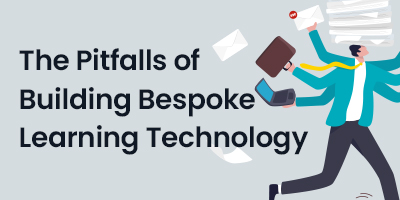As someone who’s worked in learning technology since 2016, I’m very familiar with the challenge many membership organisations face of keeping up with the latest market developments in the space. User demands continue to evolve, and learners expect more and more from the learning platforms they use. It’s also a really exciting time in EdTech – we’re seeing lots of innovative new tools coming to market and vendors are offering more interesting solutions than ever before.
However, if you’ve built your own learning platform, you have to ask yourself how much time you’re really able to devote to keeping up with these new innovations and ensuring a great learner experience. You should also consider how much time you’re devoting to the operational and administrative side of keeping it going.
Investing in modernising your learning experience is a great opportunity to make exciting, innovative changes. However, existing technical debt and operational costs can quickly detract from that excitement.
According to MemberWise’s Digital Excellence 2022 Report, many membership organisations are operating on learning platforms delivered through open source providers. Whilst open source platforms offer flexibility, they do also require a lot of manual development to get the solution just how you want it. Another 33% of membership organisations use bespoke learning systems, which also require a lot of time and effort to build and maintain in-house. For organisations in the later category, keeping up with competitors’ learning experiences and learner expectations may only be possible with a pivot in technology and infrastructure.
So what’s the answer? Continue to build, or consider buying your learning platform?
Why do organisations opt for homegrown learning platforms?
“Off the shelf solutions won’t work for us.”
This is something we hear a lot. The concerns may be as simple as the lack of customisable branding, or as complex as the platform not supporting a large, international audience with a wide range of learning requirements. This can often lead companies to believe that the best option is to build a learning platform in-house to ensure it ticks all the boxes and gives them maximum control.
However, building in-house brings with it a whole host of new challenges. It puts pressure on your internal development teams, can end up being very costly, and often doesn’t work out in the long term. It also means that your in-house team can become a single point of failure, especially if key team members leave the company or have other priorities, leaving you with no additional support.
On top of this, building your own learning platform requires a lot of operational overhead – not just for the development and launch, but also to manage and support your platform. The job of your in-house team isn’t done once your platform goes live – in fact, it’s only just starting, especially if you have ambitious plans to upscale or roll out new features. The pressure only increases when you need to upgrade, add new functionality, or integrate with other systems.
Where a new enterprise platform can add value
So, when might it be better to buy a learning platform than to build your own? Opting to buy an enterprise learning platform is a great option if you’re looking to maximise efficiency. It’s not just about reducing the huge resource investment needed to build a homegrown system from scratch – it’s also about leveraging the expertise of your vendor when you’re implementing, configuring, and customising their off-the-shelf solution.
Additionally, when you buy an enterprise learning platform instead of building in-house, the efficiency gains are massive, and these can in turn deliver value in other related areas. Think about:
- Efficiency gains: Any good off-the-shelf learning platform will leverage automation to enable auto-scaling and automatic updates, meaning your internal staff don’t see their time swallowed up by managing upgrades, maintenance, platform support and troubleshooting.
- Freeing up your in-house team: In the same vein, buying a learning platform will ensure that your developers and administrators can focus their time and energy on business-critical work, rather than managing the day to day maintenance of an in-house platform.
- Faster time to value: Achieving ROI from your homegrown solution is possible, but it’s a long and often treacherous road. Opting for an off-the-shelf solution gives you a head start, as you can hit the ground running from day one with a fully configured platform that’s ready to go.
- Integrating with your ecosystem: Nobody enjoys setting up integrations within the tech stack, but when you’ve developed your platform in-house, it suddenly becomes much more challenging. Choosing an off-the-shelf solution often means you benefit from ready-made integration options and APIs for minimal disruption and hassle.
- Understanding the data: Learning teams have never been under more pressure to prove the value of their efforts, which is why stellar reporting is a must-have for any learning platform. This can be very challenging to build and configure from scratch, whereas an enterprise learning platform includes pre-built reporting functionality that can help you demonstrate the impact of your learning platforms effectively straight away and with no complicated data engineering necessary.
Consider headless technology for your long-term business objectives
If you’re currently weighing up your options and are still unsure as to whether you should build or buy your next learning platform, it might initially feel a bit like a lose/lose situation. Building in-house means adding heavy operational costs and additional manual work, whilst buying off-the-shelf could risk you having to compromise on the learning experience you want to deliver.
But… What if you could have your cake and eat it too?
To get the best of both worlds, why not consider a headless LMS? It’s a scalable, affordable learning solution that combines the benefits of both building and buying your learning platform. A headless LMS decouples the front-end experience from the back-end, which puts you in complete control of the platform and gives you as much flexibility as you need to extend and customise the existing functionality without the heavy load of building everything in-house.
What’s most exciting to me is how much headless LMS technology has taken off in the last year, and the benefits are only becoming clearer as more and more forward-thinking organisations adopt this exciting new technology. In particular, for organisations with multiple custom systems trying to find a solution that works across the board, a headless solution really is a game changer.
If you’re under the impression that buying an off-the-shelf learning platform will limit your control and hinder your innovation, think again. The learning industry has moved on. Now, if you can dream it, you can build it.
Thought Industries powers the business of learning with the industry’s leading enterprise learning platform for customer, partner, and professional training. Interested in learning more about headless LMS technology? Schedule a demo to see how it works.










Leave A Comment